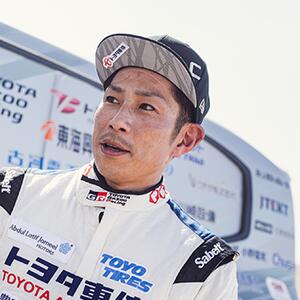T-Mode
T-Mode simulation platform

The company's own T-Mode development system has been used at Toyo Tires since 2000 to further develop tyres. After intensive research and development, Toyo Tires succeeded in fundamentally reforming the system. With the latest version of T-Mode, the tyre development process is not only much more efficient, but also faster. In the future, tire development will be advanced at this new level through the use of the improved T-Mode.
Simulation-based tyre construction
As the only part of the vehicle that comes into contact with the road, tyres play an important role in meeting the various performance requirements of vehicles. The way a tyre works is due to the interaction of the most varied of components. The rubber compound, tread design and carcass are all responsible for the tyre's performance. Another important factor in the evaluation of a tyre is the vehicle, combined with the specific properties, such as the number of passengers, vehicle model information, loads, driving patterns, etc. When T-Mode was introduced, Toyo Tires combined two simulation technologies with supercomputers for the first time. Since then, both the tyre simulation and the driving simulation have been used,
From the old "T-mode" to the new "T-mode"
The competition for technological advances in the mobility of the next generation has begun: Tyres must quickly experience performance and functional shifts in order to accommodate the "evolution of mobility", e.g. Electric vehicles and the spread of autonomous driving to take into account. Precision and the possibility of fast construction will be decisive in the future.
The innovative T-Mode system has now been fundamentally further developed. Toyo Tires combined the existing simulation options with artificial intelligence and extended functions Combination of simulation process and data management revolutionizes the tire development process at Toyo Tires.
A revolution in the tyre development process with SPDM¹
In the tyre development process, a large number of design factors and operating conditions are taken into account and the "design, simulation, prototyping and evaluation" cycles are repeated in order to optimize the required performance and design.
In order to accelerate the product development, further capacity expansions in the simulation and the connection to high-precision constructions were necessary. The SPDM constructed in this case has revolutionized the development process of Toyo Tires.
1. Uniform management of various data and use as common assets
An essential part of the functionality is the consistent merging of all simulation data. Previously, data that designers were able to obtain from simulations was treated as data of the individual designer. However, the new T-Mode platform unifies the management of different data types as common assets and enables them to be shared by the designers. Linking these design, simulation and test data improves the informative value of the data and enables it to be developed into data for sustainable learning.
Data from simulations that are carried out by designers are automatically saved on a shared server and, by being used in new analyzes and forecasts as a database asset, help shorten the test time and the lead time of product development.
2. Apply AI and define a method for solving inverse problems
Thanks to the introduction of SPDM and the associated consolidation of design support technologies with simulation infrastructure technologies, process innovations can now be forecast at an unprecedented speed. Traditionally, the solution process has consisted of entering design specifications and running a simulation, and then deriving performance values from the results. If the performance values did not meet the requirements, the design specifications were revised and the simulation repeated. This resulted in an extension of the entire process.
Obtaining design data for structures, shapes and patterns required to achieve target performance using the "Inverse Problem Solution" is essentially a means of entering the required performance values, which can be obtained through the AI using the required design specifications. Technologies are derived. From now on, all data will be structured and merged. This significantly reduces the number of necessary simulations because the most promising simulations are carried out from the outset. This speeds up the development process.
Development of aerodynamic simulations
New technologies and alternative drives also pose new challenges for tyres. In May 2018, Toyo Tires announced that it had developed its own Mobility Aerodynamics (aerodynamic simulation) technology. This is used, among other things, in the development of "tyres with excellent aerodynamic properties³", which are required to further reduce fuel consumption and increase the range of electric vehicles.
Toyo Tires analyzes and predicts the aerodynamic properties of tyres and vehicles under rolling tyre contact conditions² with a simulation that is unique in the industry. The Japanese tire manufacturer uses current tyre pattern designs to correlate the tyre usage conditions while a vehicle is in motion (primarily the load on the tyres and the speed of the vehicle) with the specific conditions for various wheel and vehicle shapes and to investigate how the tyre shape changes among them Conditions changes.
Since 2018 Toyo Tires has opened up a new sector and successfully implemented predictive technologies for aerodynamic properties³ of entire vehicle bodies, taking into account tyre contact with the surface, deformation and rotation.
At the end of 2019, these simulations will also be integrated into T-Mode, so that the system will be able to propose tyre designs that improve vehicle-wide aerodynamic properties. The new T-mode will thus be expanded further in the direction of predictive technologies.
Research and development
T-Mode technology has been used in tire development at Toyo Tires for many years. At the same time, engineers and scientists from Toyo Tires and the University of Osaka are working on expanding the system, making it more precise and expanding the possibilities.
Success of T-Mode
T-Mode showed excellent performance in predicting traction performance on snow, taking into account different snow qualities (fresh snow and slush). The precision of the predictions is a first breakthrough in tyre development, as the snow traction behavior of a tyre in the actual environment can be predicted very precisely. The shear resistance force (important physical quantity that describes the following: tyres with a ground contact patch made up of a large block and deep grooves, exerts a force on the snow that is resisted by the snow when the tyre shears in the direction of the contact patch) To measure real conditions, Toyo Tires worked with Tokyo University of Marine Science and Technology, from Nagaoka University of Technology and the National Institute of Technology, Nagano College. It was thus possible to precisely determine the shear force between tyre rubber and natural snow, taking into account load and speed factors.
These predictions were so reliable in the representation of block deformations when driving and braking that this technology is already being used in the development of new products for use on snow.







